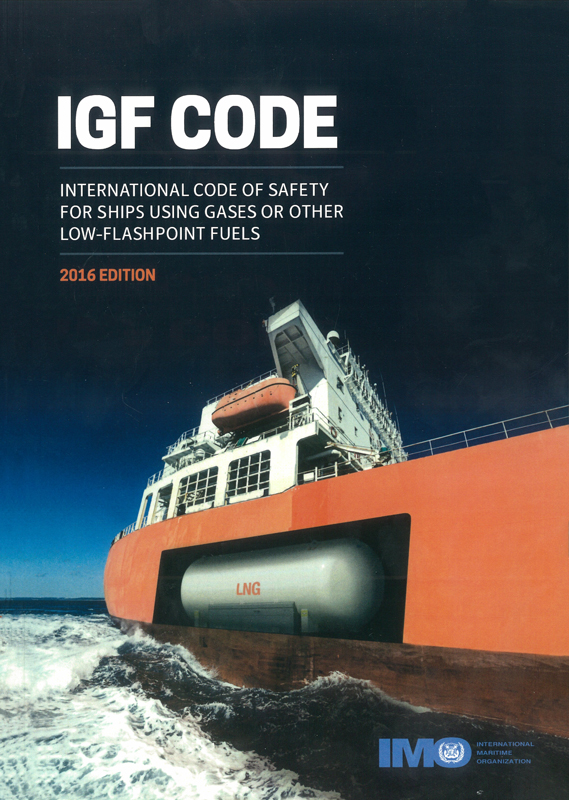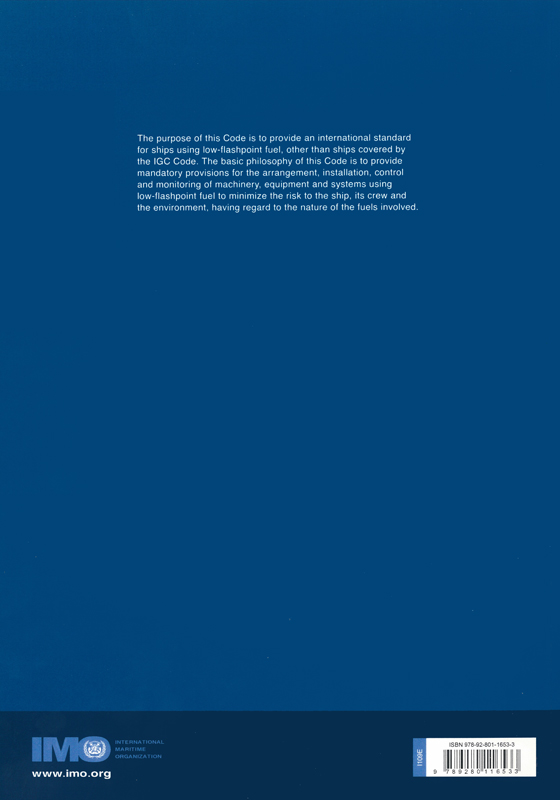Сб с 10 до 16
IGF code: international code of safety for ships using gases or other low-flashpoint fuels/Международный кодекс безопасности для судов, использующих газы или топливо с низкой температурой воспламенения.
The purpose of this Code is to provide an international standard for ships using low flashpoint fuel, other than ships covered by the IGC Code. The basic philosophy of this Code that comes into force on 1 January 2017 is to provide mandatory provisions for the arrangement, installation, control and monitoring of machinery, equipment and systems using low flashpoint fuel to minimize the risk to the ship, its crew and the environment, having regard to the nature of the fuels involved.
Contents
Foreword
International Code of Safety for Ships using Gases or other Low-flashpoint Fuels (IGF Code)
Preamble
Resolution MSC.391(95)
Adoption of the International Code of Safety for Ships using Gases or other Low-flashpoint Fuels (IGF Code)
Part A
2 General
2.1 Application
2.2 Definitions
2.3 Alternative design
3 Goal and functional requirements
3.1 Goal
3.2 Functional requirements
4 General requirements
4.1 Goal
4.2 Risk assessment
4.3 Limitation of explosion consequences
Part A-1 Specific requirements for ships using natural gas as fuel
5 Ship design and arrangement
5.1 Goal
5.2 Functional requirements
5.3 Regulations - General
5.4 Machinery space concepts
5.5 Regulations for gas safe machinery space
5.6 Regulations for ESD-protected machinery spaces
5.7 Regulations for location and protection of fuel piping
5.8 Regulations for fuel preparation room design
5.9 Regulations for bilge systems
5.10 Regulations for drip trays
5.11 Regulations for arrangement of entrances and other openings in enclosed spaces
5.12 Regulations for airlocks
6 Fuel containment system
6.1 Goal
6.2 Functional requirements
6.3 Regulations - General
6.4 Regulations for liquefied gas fuel containment
6.5 Regulations for portable liquefied gas fuel tanks
6.6 Regulations for CNG fuel containment
6.7 Regulations for pressure relief system
6.8 Regulations on loading limit for liquefied gas fuel tanks
6.9 Regulations for the maintaining of fuel storage condition
6.10 Regulations on atmospheric control within the fuel containment system
6.11 Regulations on atmosphere control within fuel storage hold spaces (Fuel containment systems other than type C independent tanks)
6.12 Regulations on environmental control of spaces surrounding type C independent tanks
6.13 Regulations on inerting
6.14 Regulations on inert gas production and storage on board
7 Material and general pipe design
7.1 Goal
7.2 Functional requirements
7.3 Regulations for general pipe design
7.4 Regulations for materials
8 Bunkering
8.1 Goal
8.2 Functional requirements
8.3 Regulations for bunkering station
8.4 Regulations for manifold
8.5 Regulations for bunkering system
9 Fuel supply to consumers
9.1 Goal
9.2 Functional requirements
9.3 Regulations on redundancy of fuel supply
9.4 Regulations on safety functions of gas supply system
9.5 Regulations for fuel distribution outside of machinery space
9.6 Regulations for fuel supply to consumers in gas-safe machinery spaces
9.7 Regulations for gas fuel supply to consumers in ESD-protected machinery spaces
9.8 Regulations for the design of ventilated duct, outer pipe against inner pipe gas leakage
9.9 Regulations for compressors and pumps
10 Power generation including propulsion and other gas consumers
10.1 Goal
10.2 Functional requirements
10.3 Regulations for internal combustion engines of piston type
10.4 Regulations for main and auxiliary boilers
10.5 Regulations for gas turbines
11 Fire safety
11.1 Goal
11.2 Functional requirements
11.3 Regulations for fire protection
11.4 Regulations for fire main
11.5 Regulations for water spray system
11.6 Regulations for dry chemical powder fire-extinguishing system
11.7 Regulations for fire detection and alarm system
12 Explosion prevention
12.1 Goal
12.2 Functional requirements
12.3 Regulations - General
12.4 Regulations on area classification
12.5 Hazardous area zones
13 Ventilation
13.1 Goal
13.2 Functional requirements
13.3 Regulations - General
13.4 Regulations for tank connection space
13.5 Regulations for machinery spaces
13.6 Regulations for fuel preparation room
13.7 Regulations for bunkering station
13.8 Regulations for ducts and double pipes
14 Electrical installations
14.1 Goal
14.2 Functional requirements
14.3 Regulations - General
15 Control, monitoring and safety systems
15.1 Goal
15.2 Functional requirements
15.3 Regulations - General
15.4 Regulations for bunkering and liquefied gas fuel tank monitoring
15.5 Regulations for bunkering control
15.6 Regulations for gas compressor monitoring
15.7 Regulations for gas engine monitoring
15.8 Regulations for gas detection
15.9 Regulations for fire detection
15.10 Regulations for ventilation
15.11 Regulations on safety functions of fuel supply systems
Annex Standard for the use of limit state methodologies in the design of fuel containment systems of novel configuration
Part B-1
16 Manufacture, workmanship and testing
16.1 General
16.2 General test regulations and specifications
16.3 Welding of metallic materials and non-destructive testing for the fuel containment system
16.4 Other regulations for construction in metallic materials
16.5 Testing
16.6 Welding, post-weld heat treatment and non-destructive testing. .
16.7 Testing regulations
Part C-1
17 Drills and emergency exercises
18 Operation
18.1 Goal
18.2 Functional requirements
18.3 Regulations for maintenance
18.4 Regulations for bunkering operations
18.5 Regulations for enclosed space entry
18.6 Regulations for inerting and purging of fuel systems
18.7 Regulations for hot work on or near fuel systems
Annex LNG-bunker delivery note



